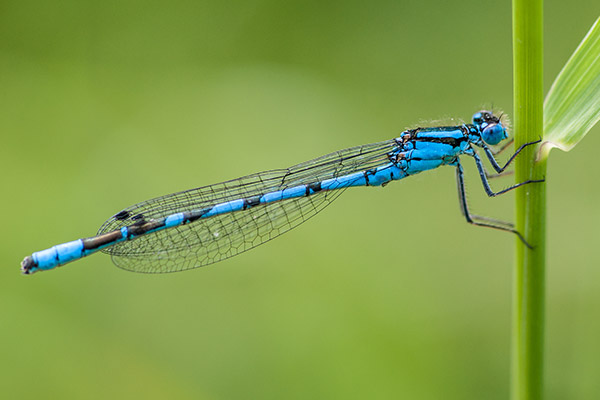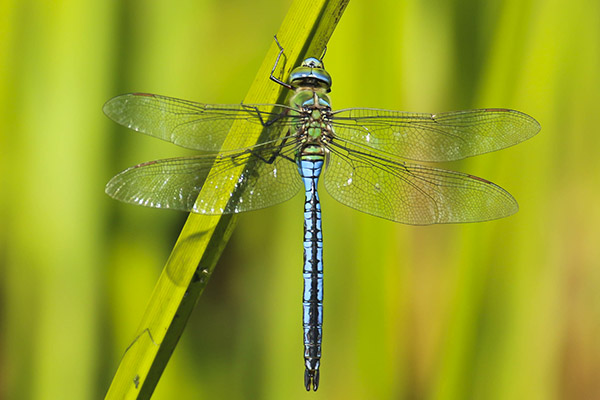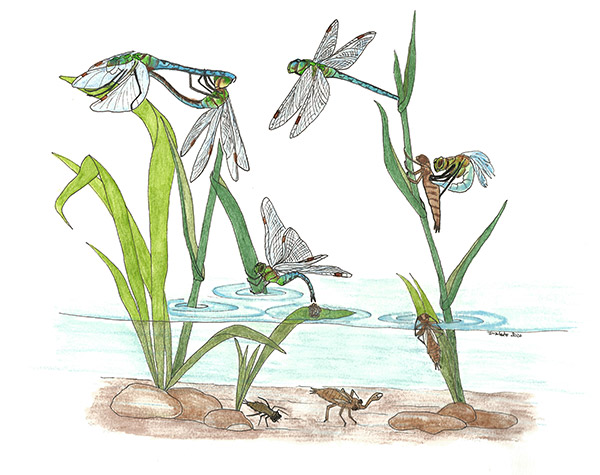Dragonflies are among the most fascinating insects that you can observe (from spring to autumn) while flying quick and fast near puddles, ponds, lakes, streams, rivers or flooded meadows. They belong to the order of the Odonata, these are the characteristics that make them unmistakable insects:
- a long and slender abdomen, divided into 11 segments;
- 4 wings, usually transparent, characterized by thick and thin veins. These wings can move separately from each other, allowing the insect to fly backwards;
- very developed and compound eyes, which make the dragonfly sensitive to any movement;
- short antennae;
- a showy and brilliant colouration, usually blue, purple, green, bronze, scarlet, pink, red, yellow, often combined with each other;
- developed and bent forward legs, used for perching and climbing on plants
The dragonflies are divided into:
Zygoptera
The term means similar wings. Also known as damselflies, they keep their wings closed, backwards on the abdomen, when they are resting. The eyes are placed on both sides of the head, distant from each other.

Anisoptera
The term means different wings. These dragonflies keep the wings spread even when resting, and the fore ones are bigger than the hind ones.
They’re better at flying than damselflies and have two big eyes joined together.

The number one predator
Dragonflies are skilful predators, both larval and adult.
The larva, which has an aquatic life (see information sheet on the vital cycle), usually lurks in the mud or in the middle of the lake vegetation, waiting for the right moment to catch a prey. In order to do it, it uses what is called "mask", that is the hinged labium, which at the moment of the attack is extruded to capture, with a fast movement, even fast animals. The larvae feed on mayflies and chironomids, molluscs, tadpoles, newt larvae in the early stages of development, fry (young fishes) and also other dragonflies.
The adult dragonfly has instead an aerial life: captures and devours its prey in flight, launching a fast and particularly silent attack, that succeeds in 95% of cases. This makes this insect, one of the most formidable predators in nature. Its main preys are gnats, mosquitoes, butterflies, mayflies and caddisflies. It has a mouthpart suitable for chewing the preys, characterized by strong toothed mandibles.
Life cycle
The peculiarity of the life cycle of dragonflies and many other insects, is to have an aerial phase (adult) and an aquatic phase (larva): let’s see it more closely!
To mate, the male grasps the female until it takes a strange position that looks like a heart. The female lays the eggs in water, leaving them in the vegetation or spreading them: in a time ranging from 2 weeks to a few months, depending on the species, originate aquatic larvae. These larvae moult several times, until they climb up a reed and get out of the water. Once done, the metamorphosis into adult begins: the exuvia covering the larva, dries and break at the level of the abdomen. The dragonfly comes out of this envelope, begins to spread the wings and extend the abdomen, reaching the final size; this process can last from a few minutes to about two hours.

Bioindicator
Dragonflies are considered "bioindicators" of environmental health. They live in clean water, therefore the reduction or disappearance in a stream, lake or other aquatic environment, may suggest a decline of its quality.